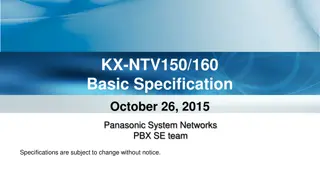
cDNA and Genomic Libraries in Biotechnology Studies
Explore the world of cDNA and genomic libraries in biotechnology, including their importance in gene analysis and gene function studies. Learn about the construction, synthesis, and screening processes involved in these libraries, along with their specific applications in identifying new genes and studying differential gene expression.
Download Presentation

Please find below an Image/Link to download the presentation.
The content on the website is provided AS IS for your information and personal use only. It may not be sold, licensed, or shared on other websites without obtaining consent from the author. If you encounter any issues during the download, it is possible that the publisher has removed the file from their server.
You are allowed to download the files provided on this website for personal or commercial use, subject to the condition that they are used lawfully. All files are the property of their respective owners.
The content on the website is provided AS IS for your information and personal use only. It may not be sold, licensed, or shared on other websites without obtaining consent from the author.
E N D
Presentation Transcript
cDNA AND GENOMIC LIBRARIES MRS. S.AMIRTHAM ASSITANT PROFESSOR PG & RESEARCH DEPARTMENT OF BIOTECHNOLOGY BON SECOURS COLLEGE FOR WOMEN THANJAVUR
INTRODUCTION A DNA library is a collection of DNA clones ,gathered together as a source of DNAfor sequencing, gene discovery , or gene function studies . There are two types of DNAlibraries: 1.DNA 2. Genomic
cDNALIBRARY AcDNAlibrary is a set of cDNAclones prepared from the mRNAs isolates from a particular type oftissue. The cDNA library contains only complementry DNAmolecules synthesized from mRNA molecules in acell. This molecules represents all the gene that are expressed in thecell at different stage of itsdevelopment.
No cDNAwas made from prokaryotic mRNA Prokaryotic mRNA is veryunstable. Genomic libraries of prokaryotes are easier to make andcontain all the genome sequences.
cDNA Libraries Are VeryUseful For Eukaryotic Gene Analysis Condensed protein encoded gene libraries,Have much less junk sequences cDNAs have no introns genes can be expressed in E.coli directly Are very useful to identify new genes Tissue or cell type specific(differential expression of genes)
Synthesis of Cdna: FIRST STAND SYNTHESIS: materials as reverse transcriptase, primer(oligo(dT) or hexanucleotides)and dNTPs SECOUND STRAND SYNTHESIS: best way of making full- length cDNA is to tail the 3 - end of the first strand and then use a complementary primer to make thesecound.
CONSTRUCTION cDNA libraries are constructed by synthesizingcDNA from purified cellular mRNA via oligo(dT)-cellulose chromatography. This is done to recover the poly(A) mRNA so as to anneal with the oligo(dT) chains .
SCREENING A prope is a piece of DNA or RNA used to detect specific nucleic acid sequence by hybridization ( binding of two nucleic acidchains by base pairing). Oligonucleotide can be used as aprobe. They are radioactivity labeled so that the hybridized nucleicacid can be identified by autoratiography.
Two general approaches are avilable for screening librariesto identify clones carrying a gene or other DNA region ofinterest. Detection with oligonucleotide probes that bind to the clone of interest . Detection based on expression of theencoded protein.
A PLASMID cDNALIBRARY FOR SCREENING
GENOMIC LIBRARY Is the largest type of library which consist of thecomplete genome of a complete genome of a particular organism which is cleaved into thousands of fragments, are all the fragments are cloned by insertion into a cloningvector. Acollection of clones that collectively represent all the DNA sequences in the genome of a particularorganism.
CONSTRUCTION The first step in preparing a genomic library is partial digestion of the DNAby restriction endonucleases, such that any given sequences will appear in fragments of a range of sizes and is represented in the library. Secondly,the cloning vector ,such as a BAC or YACplasmid ,is cleaved with the same restriction endonucleaseand ligated to the genomic DNAfragment.
Thereafter ligated DNA mixture is then used to transform bacterial oryeast cells to produce a library of cell types,each type harboring a different recombinant DNAmolecule. Each transformed bacterium or yeast cell grows into a colony,or clone ,of identical cells,each cell bearing the same recombinantplasmid. The ability to clone such large DNA fragments raise the possibility ofthe Genomic library,but it has been found that there is a problem as to what number of clones are required to construct a genomiclibrary.
A solution has been provided with thw use of afornuker: N=ln(1-P)/ln(1-a/b) Which enchances the capacity of constructing a genomic library,and also ease the problem of screening.(i.e..the higher the fragments,the smallerthe number of clones).
SCREENING A common method of screening is the plasmid- based genomic libraries which is to carry out a colony hybridization experiment. Host bacteria containing either a plasmid based orbacteriophage- based library are plated out on petri dish and allowed to grow overnight to formcolonies.
CONCLUSION In conclusion, genomic DNA segments can be organized in librariesknown as genomic libraries and cDNA libraries with a wide range of designs and purposes.




